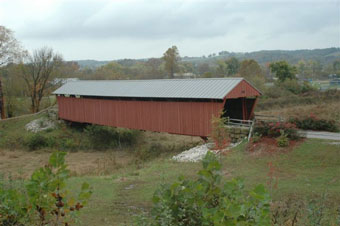
Perhaps the most “well-traveled” of West Virginia’s covered bridges is the Milton Bridge. Also known as the Mud River Covered Bridge, this 14-foot-wide, 208.5-foot-long Howe truss bridge was built in 1876 by R.H. Baker and served vehicular traffic on Cabell County 25 until deterioration limited its use to pedestrians only in 1985. A new bridge was constructed upstream in 1991 and the covered bridge was closed even to pedestrians in March 1996.
In December of that year, Orders Construction Company, Inc. of St. Albans was awarded a $224,840 contract to secure the historic structure until plans for its restoration could be completed. Only a short time before the 1997 flooding that could have destroyed the bridge, the contractor stabilized and moved it—without roof, floorboards or siding boards—to a less flood-prone site on County 25 about a mile southeast of its original location, where it could be stored. Here, on the old approaches of another former covered bridge, the James River and Kanawha Turnpike’s original crossing of Mud River, the bridge was expected to be rebuilt in 1998, using the abutments from the crossing’s original covered bridge as well as stone from the Milton site to maintain the historic aspects of both.
But in February 2001 bids were once again taken to move the 125-year-old structure—this time to a location with greater opportunity for pedestrians to experience its unique link to the transportation of the past. The bridge’s new home is over a pond at the site of the Pumpkin Festival and Cabell County Fair near Blenko Glass and a popular ball field in Milton. Ahern & Associates, Inc. of South Charleston was awarded a $900,000 restoration contract, which allowed the bridge to be moved as it was and called for new concrete abutments to be encased in the stone from the original site, truss repair, installation of a stainless-steel roof and addition of wooden siding to resemble the original.
That October, the restored structure was dedicated at the fairgrounds site in a ceremony that also recognized the continuing efforts of individuals such as the late John Brunell, Highways’ Covered Bridge Program project manager, who worked hard to save these historic structures.